Artichoke:
What is it?, history, cultivation, nutritional value, uses, recipes, and more...
The artichoke is a herbaceous plant of the Cynara genus that possesses great medicinal properties, including promoting cholesterol reduction, aiding in weight loss, combating anemia, relieving gas, regulating blood sugar levels, among others. Additionally, it is one of Peru’s main export products.
Índice
What is an artichoke?
The artichoke is the fruit of the globe artichoke (Cynara scolimus), a robust and perennial plant that can reach a height of up to 2 meters. It has highly lobed, spineless leaves of a light green color with whitish threads on the underside.
At the top of the stem, the artichokes appear as thick, cone-shaped heads covered in numerous leathery bracts. The tender and edible part is found at the base of these bracts. As the bracts mature, they become harder and are no longer edible.
The fruit of this plant is a rigid capsule, also known as an achene, which does not split open at the center and contains a single seed inside. This inflorescence is globular or elongated and measures about 12 cm in diameter. It has a green or purple base, and its flowers are surrounded by protective leaves that cluster around them. It is characterized by its rough and somewhat bitter taste and is consumed while still immature, before it opens.
Thanks to its root system, which allows it to store reserves and sprout every season, the artichoke can live for several years. Its roots extend to a depth of 40 to 45 cm.
The History of the Artichoke
The first references to the artichoke can be found in engravings in the pyramids of Egypt. It is also known that the Greeks were already familiar with and used it as both medicine and a love elixir. The Roman writer Columella, an agronomist of ancient Rome, explained in his work “De re rustica” that cynaras can be planted at two different times in the same year and that they should be fertilized with ashes.
Its scientific name, “Cynara scolymus,” comes from a Greek myth that explains the origin of this fruit. The myth narrates how Zeus once visited the Island of Cynara, where he discovered a beautiful young woman named Cynara lying on the beach. He fell madly in love with her and took her to Mount Olympus, where he made her a goddess. However, Cynara soon grew tired of this paradise and returned to her native island. Enraged, Zeus caused hard green leaves to grow on her body, enclosing her heart in the center.
While the artichoke was already known in the Iberian Peninsula during Roman times, it was the Arabs who popularized its consumption and cultivation, as reported in the “Book of Agriculture” by agronomist Ibn-aI-Awam (12th century).
During the Middle Ages, the plant went virtually unnoticed, but its reputation as an aphrodisiac food was not forgotten, and young women in their “marriageable age” were forbidden to consume it. It is believed that during this time, horticulturists who cultivated cardoons transformed them into the artichoke we know today.
The artichoke was already consumed in Italy in the 15th century. According to tradition, it was the Florentine Catherine de’ Medici, who enjoyed eating artichoke hearts, who introduced the plant to France when she married Henry II. The queen adored its flavor and considered it aphrodisiac, so she taught how to prepare it in a stew called “beatilles,” which was cooked with cock’s crests, kidneys, and sweetbreads. This stew became very popular because it was believed to have greater aphrodisiac properties than any love potion.
Later, it was the Spanish and French colonists in America who introduced it to this continent.
This vegetable is also part of popular culture in many parts of the world. It has been the subject of sayings, riddles, children’s stories, games, poems, and more.
For example, in “Elemental Odes” (1945), Pablo Neruda includes the “Ode to the Artichoke,” which begins as follows:
“The artichoke
with tender heart
dressed up as a warrior,
erect, it built
a little dome,
kept itself
impregnable
beneath
its armoured leaves…”
Likewise, Argentine writer Julio Cortázar includes an artichoke clock in his story “Relojes” (“Clocks”) from the book “Historias de Cronopios y de Famas” (“Cronopios and Famas”), in which a “cronopio” (a drawing outside the margins, a poem without rhymes) invents an artichoke clock that hangs on the wall, and its leaves indicate the present hours.

Common name of the Artichoke
| Español | alcachofa, alcachofa picada, alcachofa real, alcachofa silvestre, alcachofas, alcachofera, alcachofero, alcacil, alcacil cultivado, alcací, alcancil, alcancilera, alcanciles, alcarchofa, alcarchofera, alcarcil, alcaucil, alcaucil cultivado, alcaucil silvestre, alcauciles, alcaucique, alcaucí, alcaulera, arcacil, arcancil, arcaucil, arcauciles, carchofa, cardillo, cardo, cardo alcachofero, cardo de comer, flor de cardo, morrilla, morrillera, penca |
| Catalán | carxofa |
| Gallego y portugués | alcachofra |
| Italiano | carciofo |
| Francés | artichaut |
| Inglés | artichoke |
| Alemán | alkatxofa |
| Vasco | artischocke |
Scientific name of the Artichoke
Cynara scolymus
Taxonomy of the Artichoke
| Reino | Plantae |
| División | Magnoliophyta |
| Clase | Magnoliopsida |
| Orden | Asterales |
| Familia | Asteraceae |
| Subfamilia | Cichorioideae |
| Tribu | Cardueae |
| Subtribu | Cardueae |
| Género | Cynara |
| Especie | Cynara scolymus |
Synonymy of the Artichoke
Cynara cardunculus subsp. flavescens Wiklund
Cynara cardunculus var. ativa Moris.
Cynara cardunculus subsp. scolymus (L.) Hegi
Cynara cardunculus subsp. scolymus (L.) Beger
Cynara cardunculus var. scolymus (L.) Fiori
Cynara communis Lam.
Cynara esculenta Salisb.
Cynara hortensis Mill.
Etymology of the Artichoke
Cynara: The generic name derives from the Greek χινάρα, -ας or χυνάρα, derived from χυων-χυνός, cyon-cynos, meaning “dog,” referring to the involucral bracts that resemble the teeth of a dog. It passed into Latin as “cinara” and was also used to designate thistles.
Scolymus: From the Latin “scǒlŷmos,” i, derived from the Greek σχόλυμος, and mentioned by Pliny the Elder in his “Naturalis Historia” as a type of thistle (XXI, 94-96), probably referring to Scolymus hispanicus or maculatus.
Artichoke: The name comes from the Arabic “al-kharshûf.”
Habitat of the Artichoke
- Habitat
Artichokes can be generated through sexual or asexual reproduction techniques. The latter technique involves vegetative means such as micropropagation, division, and root cuttings. The most common method involves separating pieces of rhizome from the mother plant and planting them, although recently varieties that reproduce by seeds are being obtained. These varieties usually produce larger plants with more spines than traditional ones.
The cultivation of artichokes requires good soil, regular soil irrigation, nutrient supply, and protection against frost in winter. Artichoke shoots are harvested by cutting them from the plant, and spring is the peak season for harvesting. They usually have a good shelf life and remain quite fresh when stored for up to fifteen days.
It is considered a winter plant (cold season) and grows best in daytime temperatures of 24°C and nighttime temperatures of 13°C.
Currently, artichoke cultivation is mainly concentrated in countries in the Mediterranean basin, parts of North Africa, North America, and South America. Peru and Argentina are the main artichoke producers in South America.
According to the Association of Exporters (Adex), the main artichoke production areas in Peru are Junín (mainly in the Mantaro Valley), La Libertad, Ica, Lima, and Apurímac.
Artichokes are one of the largest export products. Currently, Peru is the world's second-largest exporter of processed artichokes and the leading supplier of artichokes to the North American market. In 2020, Peruvian artichoke exports reached 54,480 tons valued at $135 million. The most important destinations for artichokes last year were the United States with a 58% share, followed by Spain with 23%, and France with 14%.
Geographical distribution of the Artichoke

La Libertad, Ancash, Lima, Junín, Ica, Ayacucho, Arequipa, Cusco, Apurímac
Seasonal availability of the Artichoke
- Year-round
Varieties of the Artichoke
-
France
Camus de Bretaña, Verde de Laon, Violeta de Provenza, "bouquet"
-
Spain
Blanca de Tudela, Monquelina
-
Italy
Espinosa, Romanesco, Francesino, Brindisino/Catanese
-
Varieties multiplied by seed
Opal, híbrido F1 Concerto, híbrido F1 Tempo, híbrido F1 Madrigal, híbrido F1 Symphony, híbrido F1 Imperial Star. Variedad población
-
USA
Green globe Imperial Star Emerald
-
"Gauchito" variety from Argentina
Argentina and Chile. Chilena Argentina or Blanco de San Juan cultivar.
-
Spanish
Ñato Francés Oro Verde, Gurí, and Gauchito.
Nutritional value of Artichoke
While water is the most abundant element in artichokes, the next major component is carbohydrates, including notable amounts of inulin and fiber. The major minerals found in artichokes are sodium, potassium, phosphorus, and calcium. As for vitamins, artichokes are particularly rich in vitamin B1, vitamin B3, and small amounts of vitamin C.
To be more specific, young artichoke leaves contain:
- Cynarin (with effects on cholesterol)
- Caffeic and chlorogenic acids
- Bitter principles, such as cynaropricin, responsible for its bitter taste
- Flavonoids like luteolin
- Inulin, a glucoside primarily found in the root
On the other hand, the flowers of artichokes are notable for containing:
- Vitamin C (ascorbic acid)
- Fiber and minerals (mainly calcium, sodium, and potassium)
- Cynarin, with effects on cholesterol
- Flavonoids
Additionally, artichokes contain less than 1% fat and only 22 kilocalories per 100 grams, making them a suitable food for weight loss diets.
Let’s highlight the benefits of some of its components:
- Cynarin stimulates bile secretion, aiding in the digestion of fats.
- Rich in fiber, artichokes help reduce blood glucose levels while preventing constipation.
- Contains phytosterols, which contribute to controlling cholesterol levels.
- Flavonoids (quercetin and rutin) protect the body against heart diseases and promote antioxidant activity.
- Contains inulin, a carbohydrate that metabolizes slowly in the body, forming fructose instead of glucose. This makes artichokes favorable for people with diabetes.
- Artichokes also contain phosphorus, iron, magnesium, calcium, potassium, and various vitamins, including vitamin B1, vitamin C, and niacin.
Health Benefits of Artichoke
Artichoke is a fiber-rich food with low calorie content. It provides calcium, phosphorus, and vitamins B1, C, B3, B5, and B6. It is also rich in cynarin, a compound that protects the liver and stimulates bile secretion.
Contraindications or Side Effects
Artichoke is considered a natural remedy for the liver due to its active ingredients: cynarin, a substance with beneficial properties for the liver, kidneys, and gallbladder, as well as diuretic effects and cholesterol-lowering properties. It also contains inulin, a hypoglycemic polysaccharide useful for diabetes.
In traditional medicine, artichokes have been used to treat anemia, diabetes, fever, gout, rheumatism, and urinary tract stones.
Thanks to its properties, artichoke is used to treat gastrointestinal problems such as excessive gas, nausea, and vomiting. It is also believed to be beneficial for anemia, atherosclerosis, diabetes, heart diseases, hypercholesterolemia, fever, gout, hemorrhoids, rheumatism, kidney problems, urticaria, and hemorrhoids.
According to a 2017 study, artichoke extract is an excellent anti-inflammatory and antioxidant agent that may be beneficial in the treatment of irritable bowel syndrome (although more studies are needed to confirm this).
Moreover, artichoke is widely used by individuals seeking weight loss because its consumption increases satiety, helps regulate blood sugar, and reduces cholesterol levels, thus facilitating weight loss.
| 10 Porciones por Kilogramo | |
| Tamaño de porción | 100g |
| Cantidad por porción Calorías |
24 |
| Cantidad por 100g | |
| Energía | 101 kJ |
| Grasa Total | 0.2 g |
| Sodio | ● |
| Carbohidratos totales | 18.9 g |
| Carbohidratos disponibles | 4.9 g |
| Fibra Dietaria | 14.0 g |
| Proteínas | 2.2 g |
| Calcio | 42 mg |
| Fósforo | 51 mg |
| Zinc | 0.49 mg |
| Hierro | 1.00 mg |
| Potasio | ● |
| Agua | 77.8 g |
| Cenizas | 1.0 g |
| Vitamina A | 7 μg |
| Tiamina (B1) | 0.07 mg |
| Riboflavina (B2) | 0.04 mg |
| Niacina (B3) | 0.85 mg |
| Vitamina C | 1.42 mg |
| Acido Fólico (B9) | ● |
| β-Caroteno | 42 μg |
| Fuente: Tablas peruanas de composición de alimentos – Centro Nacional de Alimentación y Nutrición – Ministerio de Salud – Perú | |
Derived Products and Artichoke Consumption Methods
Uses of Artichoke
Artichoke is a versatile food that is easy to prepare and consume. Its medicinal uses are abundant due to its rich nutritional properties.
- Culinary
- Medicinal
- Industrial
- Ritual
Culinary Use of Artichoke
Artichoke is an easy-to-prepare food that can be consumed boiled, roasted, fried, pickled in vinegar or olive oil, or even raw. It is used in various dishes, including stews, sautéed dishes, legume-based dishes, salads, infusions, juices, and more. It can also be preserved in cans, either in natural form, in oil, or in vinegar. Artichokes adapt well to freezing, maintaining their organoleptic properties, and can be found in various forms such as artichoke bottoms, slices, pieces, half hearts, and hearts.
Cooked artichoke has a flavor similar to fried egg whites. In some regions of North Africa and the Middle East, artichoke meat fillings are used to enhance the flavor of meals. Additionally, the Italian liqueur Cynar also utilizes the taste of artichoke.
Due to its abundant medicinal properties, artichoke can also be consumed in industrialized capsule form.
Medicinal Use of Artichoke
Artichoke is considered a natural remedy for the liver due to its active ingredients: cynarin, a substance with beneficial properties for the liver, kidneys, and gallbladder, as well as diuretic effects and cholesterol-lowering properties. It also contains inulin, a hypoglycemic polysaccharide useful for diabetes.
In traditional medicine, artichokes have been used to treat anemia, diabetes, fever, gout, rheumatism, and urinary tract stones.
Thanks to its properties, artichoke is used to treat gastrointestinal problems such as excessive gas, nausea, and vomiting. It is also believed to be beneficial for anemia, atherosclerosis, diabetes, heart diseases, hypercholesterolemia, fever, gout, hemorrhoids, rheumatism, kidney problems, urticaria, and hemorrhoids.
According to a 2017 study, artichoke extract is an excellent anti-inflammatory and antioxidant agent that may be beneficial in the treatment of irritable bowel syndrome (although more studies are needed to confirm this).
Moreover, artichoke is widely used by individuals seeking weight loss because its consumption increases satiety, helps regulate blood sugar, and reduces cholesterol levels, thus facilitating weight loss.



